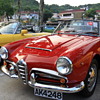Posted 11 years ago
 vetraio50
vetraio50
(759 items)
Another great survivor has to be this carved wooden Pulpit - a 'Preekstoel' in Dutch and in French a 'Chaire de vérité'. Positioned between two huge columns decorated with two of the twelve apostles it is totally over the top. T.O.T. Baroque!
It is 7 metres or 23 feet tall. It originally cost 3350 gulden.
It was carved by one member of the great the 17th and 18th century Antwerp family of sculptors : the Verbruggens or Verbrugghens.
Hendrik Frans Verbruggen (1654-1724) and his elder brother were both apprenticed under their father and had travelled to Italy to see the masterpieces of the greats. Hendrik Frans became one of the trend-setting masters of late baroque church furniture. He did lots of work for the Jesuits in the Low Countries. This pulpit was designed for another Jesuit church in Louvain. But after the suppression of the Jesuits in 1773 it was 'gifted' by the Jesuits to the Church of St Michael and St Gudula in 1776 -" under orders of Maria Theresia" I've seen mention.
The pulpit is a representation of the Fall of Adam and Eve at the bottom surmounted by an apocalyptic vision of the Virgin and child slaying the "Beast": Fall and Redemption.
When it was moved in 1776 it was damaged and repairs were carried out by J.B. van der Haeghen; perhaps the stairs are his work too.
After the Battle of Waterloo Belgium became a tourist mecca. Thousands flocked to see this pulpit which had become world famous. Victor Hugo described it as: " ... La chaire fourmillante de Verbruggen, chaire magique qui parle toujours… C'est la création tout entière, c'est toute la philosophie, c'est toute la poésie,… Tout de poème est sculpté et ciselé à plein chêne de la manière la plus fort, la plus tendre et la plus spirituelle. L'ensemble est prodigieusement rococo et prodigieusement beau…. Cette chaire est dans l'art un de ces rares points d'intersection où le beau et le rococo se rencontrent...."
A postcard published Th. Van Den Heuvel of Brussels, number 21.



























Stunning!!!!
Hi V. I came home today but family still in Florida...dang that day job. I had to go and hit some thrifts as it was a moral imperative! (For my soul). Found a ton, but what made me really think of you was a Niño Parrucca piece. Familiar? Need to do a ton of posting, it was a crazy haul. Who knew late Sunday afternoon would be so awesome a hunt time.
Many thanks SEA, AMBER, AGHCOLLECT, MANIKIN 'n GARY!
Nino Parrucca is not as well known as de Simone.
This is his site ...
http://www.ninoparrucca.it/storia_en.asp
The Italian word for a 'wig' is Parrucca ..... Therefore the google translation of Nino Wig.
Your welcome KEV :)
Sent you an email with pics.
Funny name
GREAT, - again!
Many thanks VALENTINO, BLUNDERBUSS, PHIL 'n VIOLETORANGE!
I found this amazing Dutch site that has some detailed pictures, PHIL!
http://users.skynet.be/sky78949/html/preekstoelen.html
You know I am glad there is some identification of who made this TOT carving.
So many of the wonderful things in buildings from the past have clearly been made by masters long forgotten.
Many thanks KAREN!
Many thanks MIKELV!
how wonderful to read the French...I wonder why they quote Victor Hugo?
Hugo lived for some time in Brussels ... 500 days.
Part of the period of Exile.
"Victor Hugo first visited Brussels in 1837. At the time, Hugo was aged 35 with his record of literary achievements already boasting such best-selling novels as ‘Le Notre-Dame de Paris’, ‘Le Dernier Jour d’un Condamné’ and the stage play ‘Hernani’.
During his first visit to Brussels, Victor Hugo admired the Grote Markt/Grand Place and the cathedral, which prompted him to include this first impression: ‘I am full of admiration for Brussels…’ in his ‘France et Belgique’ travel book.
Fifteen years later would see Victor Hugo make a return visit to Brussels under very different circumstances. Fleeing from Paris after Napoleon III had seized power on 2 December 1851, Hugo managed to cross the Franco-Belgian border on a forged passport under the false name of Jacques Firmin Lanvin. His mistress Juliette Drouet followed in his footsteps, carrying the manuscript for Les Misères in her luggage, which Victor Hugo would go on to work up into ‘Les Misérables’ over the next few years to come.
Same as a number of other political exiles from the day, including Alexandre Dumas, Karl Marx and Multatuli to name but a few, in Brussels Victor Hugo found a safehaven, a place that gave him freedom of thought. Spending over six months staying at the Grote Markt/Grand Place, during his time there Victor Hugo wrote ‘Histoire d’un Crime’, ‘Napoleon-le-Petit’ and a number of poems that would be published in his poetry collection entitled ‘Les Châtiments’.
When Victor Hugo left Brussels in the summer of 1852, he made a powerful public speech that called for a united Europe in no uncertain terms: “Belgians, some day there will be the United States of Europe.”
http://visitbrussels.be/bitc/BE_en/minisite_miserables150/victor-hugo-and-brussels.do
Many thanks AUSTRO!
Many thanks ANTIQUES IN NJ 'n GEO too!
Many thanks WALKSOFTLY!
Many thanks MANIKIN, ROYCROFTBOOKSFROMME'n ANTIQUES IN NJ!
Many thanks MICHAEL!
Many thanks PETEY!
Many thanks POPS52!
Many thanks INKY!
Many thanks TOM!
Many thanks TONINO!
What a feat of execution, awe inspiring.
I can't imagine moving it!
Many Thanks to you,
Tonino
It seems it was moved and badly damaged in the process. Nailed together!
Thanks TONINO & ANNE LANDERS too!